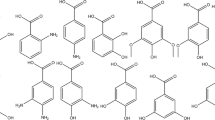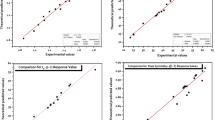Abstract
Multilinear gradient elution was applied for the simultaneous optimization of resolution and analysis times of nine chlorophenols separated by HPLC. The first relationship of ln k versus φ was determined using the isocratic retention time for each analyte. For prediction of gradient retention times of analytes, the fundamental equation of gradient elution was numerically solved. Then a grid search program was used to simulate chromatograms under each new condition. Two different chromatographic goals, analysis time and minimum distance between adjacent peaks, were evaluated simultaneously using Derringer’s desirability function for each chromatogram. The sigmoid function was used to transform the optimization criteria to desirability values. Under optimal conditions, a good agreement was observed between predicted and experimental values of the chromatographic response function when analysis time was less than 40 min.

Similar content being viewed by others
References
Jandera P, Churacek J (1985) Gradient elution in liquid chromatography: theory and practice. Elsevier, Amsterdam
Poole CF (1985) The essence of chromatography. Elsevier, Amsterdam
Snyder LR, Dolan JW, Gant JR (1979) J Chromatogr A 165:1–10
Snyder LR, Stadalious MA, Quarry MA, (1983) Anal Chem 55:1412A–1418A
Snyder LR, Dolan JW (1998) Adv Chromatogr 38:115–121
Hutta M, Gora R (2003) J Chromatogr A 1012:67–75
Huang D, Zhang Y, Chen X, (2003) J Chromatogr B 784:101–111
Nikitas P, Pappa-Louisi A, Papageorgiou A (2007) J Chromatogr A 1157:178–186
Nikitas P, Pappa-Louisi A, Agrafiotou P (2006) J Chromatogr A 1120:299–307
Bourguignon B, Massart DL (1991) J Chromatogr A 586:11–21
Glajch JL, Kirkland JJ (1989) J Chromatogr A 485:51–59
Hadjmohammadi MR, Safa F (2004) J Sep Sci 27:997–1008
Safa F, Hadjmohammadi MR (2005) J Chromatogr A 1078:42–51
Snyder LR (1964) J Chromatogr A 13:415–434
Nikitas P, Pappa-Louisi A (2005) Anal Chem 77:5670–5677
Coenegracht PMJ, Smilde AK, Metting HJ, Doornbos DA (1989) J Chromatogr A 485:195–203
Massart DL, Vandeginste BGM, Buydens LMC, De Jong S, Lewi PJ (1997) Handbook of chemometrics and qualimetrics, part A. Elsevier, Amsterdam
Harrington EC (1965) Ind Qual Control 21:494–502
Derringer G, Suich R (1980) J Quality Technol 12:214–221
Drouen ACJH, Schoenmakers PJ, Billiet HAH, de Galan L (1982) Chromatographia 16:48–57
Divjak B, Moder M, Zupan J (1998) Anal Chim Acta 358:305–312
Hadjmohammadi MR, Kamel K, Fatemi MH (2007) J Sep Sci In press
Nikitas P, Pappa-Louisi A, Agrafiotou P (2002) J Chromatogr A 946:33–45
Pappa-Louisi A, Nikitas P, Balkatzopoulou P, Malliakas C (2004) J Chromatogr A 1033:29–41
Author information
Authors and Affiliations
Corresponding author
Rights and permissions
About this article
Cite this article
Kamel, K., Hadjmohammadi, M.R. Application of Multilinear Gradient Elution for Optimization of Separation of Chlorophenols Using Derringer’s Desirability Function. Chroma 67, 169–172 (2008). https://doi.org/10.1365/s10337-007-0458-5
Received:
Revised:
Accepted:
Published:
Issue Date:
DOI: https://doi.org/10.1365/s10337-007-0458-5




